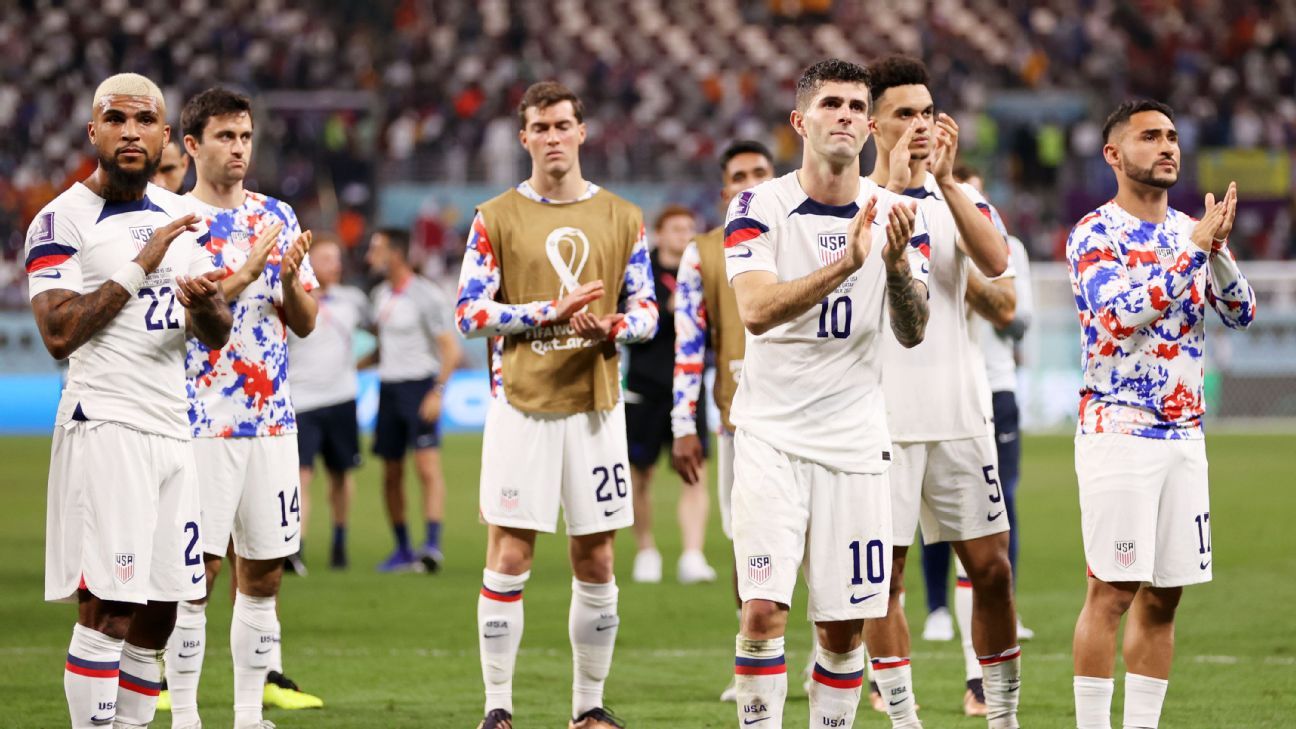
Is this USMNT team better or worse than the World Cup one?
- Sports
- June 23, 2024
- No Comment
- 132
When the U.S. men’s national team bowed out of the 2022 FIFA World Cup in the round of 16, there was disappointment, but also excitement about what could lie ahead. The roster was the youngest team at the tournament weighted by minutes played, with more players getting substantial playing time in top leagues than in the past. With a World Cup now under its belt, the thinking was that the USMNT would continue on an upward trajectory.
With the U.S. now heading into Copa América, starting with Sunday’s group stage opener against Bolívia, the question now stands: Is the U.S. better now than at the end of the last cycle? That of course depends on which numbers you use, as well as the subjective eye test. It’s not always an easy assessment. The two most recent friendlies against Colombia (a 5-1 loss) and Brazil (a 1-1 draw) provide fodder for both sides of the argument.
“We’ve had opportunities to try to prove ourselves against top opposition since the World Cup, and there have been times where we’ve played really well, and there have been times where there was obvious room for improvement,” goalkeeper Matt Turner said during a roundtable with reporters.
“So I think the biggest thing that we’ve learned about each other is that we can’t accept the status quo. I think we have to demand a lot from each other on the pitch, whether it be training, whether it be the games, whenever we’re together, because as talented as we are, we’re only as good as we are intense.”
Based on the FIFA and Elo rankings, the current version of the USMNT is marginally better. At the end of 2022, the U.S.’s FIFA ranking was 13th from 1653 points, while its Elo ranking was 23rd from 1819 points. Eighteen months later, the respective rankings were 11th for FIFA from 1677 points and 21st for Elo even as the points dropped to 1790.
So yes, that draw against Brazil, not to mention winning the Concacaf Nations League twice, helped offset the embarrassing defeat in the CNL to Trinidad and Tobago. And it’s worth remembering that because of the limitations of the international soccer calendar, the USMNT schedule is going to be comprised mostly of Concacaf opposition.
Looking at the numbers from the U.S.’s slate of games this cycle compared to the last tells a similar story, though it’s not quite an apples-to-apples comparison. Because the U.S. is co-hosting the 2026 World Cup with Canada and Mexico, there are no World Cup qualifying games to fill up the schedule, so the 23-game stretch this cycle has a slightly larger percentage of friendly games (43.5%) than the 56-game run-up to the 2022 World Cup (37.5%).
That might explain why most attacking stats on a per-90-minute basis are up compared to the run-up to the 2022 World Cup, including goals (2.1 in the 2022 cycle compared to 2.25), chances created (9.09 to 11.38) and shots on goal (5.1 to 5.75). The one worse metric is xG (1.7 to 1.9).
On the defensive side of the ball, the trend is mostly positive. Goals allowed per 90 minutes is up (0.56 during the 2022 cycle to 0.88) — that heavy loss to Colombia didn’t help — though xG against is slightly down (0.96 to 0.87). The same is true for chances conceded (7.59 to 6.46), while shots on goal conceded (3.21 to 3.17) is essentially even.
1:09
Will home-field advantage be a factor for USMNT vs. Bolivia?
Shaka Hislop discusses whether the USMNT have an advantage against Bolivia as hosts ahead of their Copa America clash.
Not everything can be explained by the numbers, however. Some of what will transpire over the next month is about available personnel and current form. Defensively, it’s tough to argue that the USMNT is better off. The lack of playing time for goalkeeper Turner seems less than ideal, his performance against Brazil notwithstanding.
The bigger concern is the injury-hit season experienced by holding midfielder Tyler Adams. His skill set has a massive impact in terms of the U.S. midfield, given his ability to cover ground and break up attacks. In an exclusive interview with ESPN before the Brazil friendly, Adams said he was “ready to play a role,” and he did get on the field for 14 minutes. But the USMNT will need Adams to be at his midfield-destroying best if it is to go far in the tournament.
Like so many things with the U.S., the attack has experienced some positives and negatives. The negative is the torn ACL injury to Sergiño Dest. While ostensibly an outside back, Dest’s ability to get into the attack and cause problems with his passing and dribbling is irreplaceable, leaving the U.S. with one less attacking option to deploy.
The forward position has long been a sore spot for the U.S. under manager Gregg Berhalter. For what seemed like ages, no player managed to stake a claim to the spot. It’s worth remembering that Jesús Ferreira started a World Cup game for the U.S.
That dynamic has now changed. While it would be a stretch to say the USMNT now enjoys an embarrassment of riches at the position, Berhalter at least now has options. Folarin Balogun was thought to be the savior at forward, though he has yet to make a big impact. That said, his talent is clear, and part of the issue is that his teammates seem unable to find him with the kind of passes behind the opposition defense on which he thrives.
Josh Sargent’s bigger frame and versatility make him an intriguing option, but a lingering foot injury barely healed up in time for him to make the Copa roster, and it’s unclear how big a role he’ll be able to play. Ricardo Pepi has proved adept in a super-sub role — five of his 10 international goals have come off the bench — though he’ll be angling for more minutes. Haji Wright has been penciled in as a winger, though he can fill in a more central role.
Quality service will go far in determining how successful the forwards will be, and creativity is an area where the U.S. looks poised to make the biggest improvement. The issues involving Berhalter and Gio Reyna have been well documented, but with the two moving on from their World Cup feud and its aftermath, Reyna now looks poised to take on a bigger role, either by scoring goals or setting them up. Similar to Adams’ availability, his ability to meet the moment of this tournament will have a huge say in terms of how far the U.S. goes.
How Reyna will be used is also a factor. Berhalter has at times relied on Reyna to drop deep to help initiate the attack. But there is also a desire to get Reyna further upfield and into dangerous spots.
“Now it’s sort of finding the balance of coming deeper, but at the same time getting in the attacking third and still creating transitions for the team and scoring goals and getting assists,” Reyna said during a roundtable with reporters.
“So these last few days we’re still working on that a lot, [just] the balance of coming deep and staying higher, but he just wants me to be involved in a few different aspects of the game and build up is one that he wanted me to be a bit more involved in.”
There also seems to be more depth now than the U.S. had in 2022. The additions of players such as Johnny Cardoso, Pepi and Malik Tillman, all of whom have European experience, augment that of new starters Chris Richards and Balogun.
Then there are the intangibles. The World Cup provides this team with a level of experience that it didn’t have before. The U.S. should be wiser in terms of managing games and navigating a tournament. The two aforementioned friendlies highlight how this is an ongoing process, and require playing as a unit.
“I think a lot of times, especially playing in Concacaf games, we can kind of get away with just being individuals,” Richards said.
“I think you saw that in the Colombia game. That’s why we got killed in that we were just playing as if it was a regular Concacaf game. I think that was kind of a warning for us, kind of an eye-opener, that if we want to be able to beat big teams, we want to be able to compete with big teams, that we can’t just play however you want to play. You have to play as a team.”
Add it up, and by just about any measure the current edition of the USMNT seems a little bit better than its 2022 World Cup counterpart. But results in the Copa América will be the ultimate metric.
#USMNT #team #worse #World #Cup









